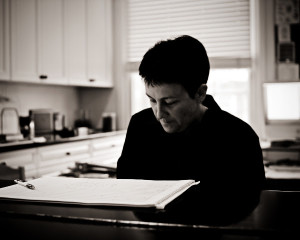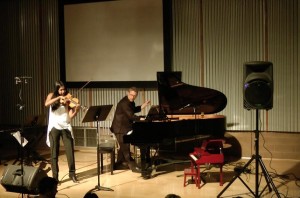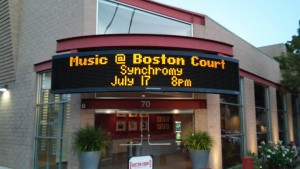One of the major threads of the programming of the 2015 Proms concerts was the 90th birthday of Pierre Boulez. This commemoration is both testimony to the importance of Boulez to the music of the second half of the twentieth century, and also to his importance in the history of the BBC and to the Proms. The Prom on August 12 situated a major work of Boulez, Figures – Doubles – Prismes in the context of two of his musical forebears, Ravel and Stravinsky. On August 26, in the concert which was the Proms debut of the SWR Symphony Orchestra Baden-Baden, another major work of Boulez’s, was presented alongside an important work of his contemporary György Ligeti. “…explosante-fixe….” began as short work (a page of musical notation with several pages of written instructions) which was part of a memorial tribute to Stravinsky organized by the magazine Tempo. The notes of this fragment gravitated to the note E♭, Stravinsky’s musical initial (S=E♭). Boulez produced various expansions of this original material for different ensembles, each version, like the original, called “…explosante-fixe…” and involving live electronics, but each seems to have been unsatisfactory to the composer due to technological difficulties. This “…explosante-fixe…”, which is a sort of concerto for flute, two ‘shadow’ flutes, and a chamber orchestra, with electronics, written between 1991 and 1993 (after further technological advancements), is not exactly a final version of the work, since the plan for the piece was that a relatively simple statement of the material, “Originel,” ending with an E♭, would be arrived at after moving through a cycle of seven “Transitoires,” which in turn were mediated by electronic “Interstitiels.” The present version has only two Transitoires (VII and V). One might be grateful, though, for this, since as it is the work is thirty-four minutes long; and at that length the constantly changing glittering texture and the shimmering instrumental writing remains continually fresh and beguiling. The performance, by soloist Sophie Cherrier, with shadow flutists Dagmar Becker and Anne Romeis, and a subset of the orchestra, the SWR Experimental Studio, conducted by François-Xavier Roth, was ebullient and aurally seductive and thrilling, and was altogether completely satisfying.
“…explosante-fixe..” was set along side of Ligeti’s Lontano, a work for huge orchestra, which, using more or less the same micropolyphonic techniques that in his earlier iconic orchestral masterwork Atmosphéres produced clustery sound masses, evokes the textures and ethos of late nineteenth century orchestral music. Ligeti said that as he was writing Lontano he had in mind some lines from Keats’s “Ode to a Nightingale,”
“…The same that oft-times hath
Charm’d magic casements, opening on the foam
Of perilous seas, in faery lands forlorn…”,
and as Stephen Johnson wrote in his program note, the work has several moments when it seems that a window is flung open, revealing a startlingly new vista, with yet another vista in turn opening up, continuing into infinity. The orchestra and Roth, just about perfectly realized the beauty and poetry of this work, following it with one of the most important works of one of the most important influences on Ligeti, the Bartok Concerto for orchestra.
The BBC Proms Matinee on August 29, presented by the London Sinfonietta, conducted by Thierry Fischer, offered three other important works of Boulez’s, this time situating them with works of younger composers following in his wake, Helen Grime and Christian Mason. The concert opened with Memoriale, an intermediate version of “…explosante-fixe…”. Boulez was working on developing the work at IRCAM with the flautist Lawrence Beauregard during the early 1980s, but Beauregard’s untimely death in 1985 at the age of 28 caused Boulez to suspend his work, after writing Memoriale in his memory. The seven minute long piece is a meditative flute solo (played in this performance by Michael Cox) surrounded by a quietly and elegantly whirring instrumental texture. The clarinetist Mark van de Wiel performed Domaines, an unaccompanied solo work which is possibly the signal product of Boulez’s interest in controlled chance. The work consists of six ‘cahiers,’ or pages, which can be played in any order, which are then followed by six ’mirroirs’, mirror versions of the original ‘cahiers’, which can also be played in any order; each of the cahiers and mirroirs contains six fragments whose order can be varied in a particular way. Eventually, like “…explosante-fixe…” Domaine was expanded by the addition of six additional instrumental sections for from one to six instruments. This rather dazzling solo virtuoso piece received a completely dazzling performance.
The concert concluded with Éclats/Multiples, yet another, in principle, unfinished work consisting of, at the moment, an approximately ten minute long piece for fifteen players, featuring the contrast of instruments whose sound is hard, unchanging, bright, and clanging, and produced percussively, with those whose sound can be prolonged, and whose continuity and speed of figuration can be decided, within certain bounds, by the performers, followed by an approximately seventeen minute long piece for twenty five players (adding nine violas and a bassett clarinet), expanding, darkening, and prolonging the more sustained music from the first part. The performance of the work was vivid, fluent, eloquent, and engaging, and was a suitably spectacular ending for the concert and for the Proms’s birthday celebrations.
Between the works of Boulez were works of composers who, having been born about sixty years later than he was, might be considered part of his progeny. Both Helen Grime and Christian Mason have worked with Boulez and both attested in discussions with Tom Service before the performances of their pieces, proudly and happily claimed to have been profoundly influenced by him, particularly by his ear and mind for detail. Helen Grime’s A Cold Spring, for ten players, is in three movements: a prelude featuring fluttering parts for two clarinets, a serious singing movement featuring a solo horn, and a concluding much more dramatic movement in which the clarinets reappear as featured players. It is concisely and elegantly made and attractively orchestrated. Christian Mason’s Open to Infinity: a Grain of Sand, which was commissioned jointly by the BBC and the Lucern Festival, received it’s UK premiere. Its three movements, played without a break, spurred on by the Blake poem referenced in its title, explore the relationship between the material of the work and the larger parts and, in turn, the whole which it generates. It begins with a rather static, chordal movement, followed by agitated and rhythmically active music, which develops a dramatic trajectory, and ends with slower contemplative music which evolves into a sort of slow motion struggle towards its end. All of this arises from and fades back into the sound of the crotales which all fourteen of the performers play in addition to their other instruments. The pacing of the work and the drawing out of the arc of its argument is masterly and compelling. The playing of the members of the London Sinfonietta throughout the concert was a demonstration of how to bring all this very difficult music to vivid life.
All of these performances are available on the BBC iplayer.
(August 26: http://www.bbc.co.uk/events/emdc8g#b06709hk ;
August 29: http://www.bbc.co.uk/events/e4pxj5#b067x658 ;
or the individual pieces can be found here: http://www.bbc.co.uk/programmes/p02pcr1d )


